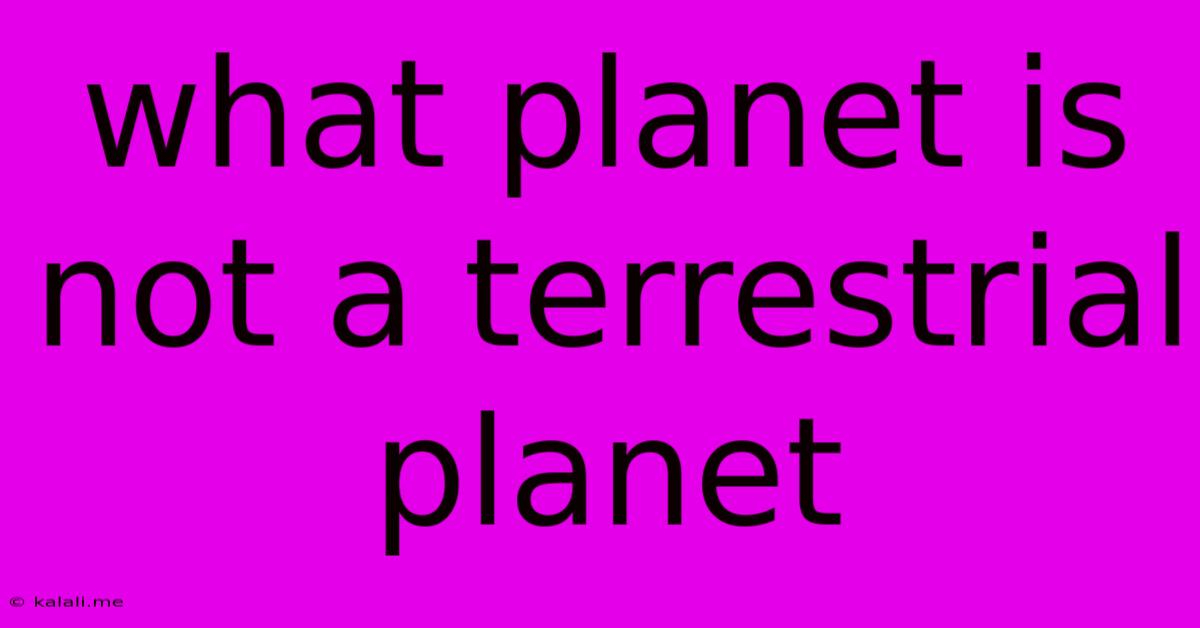What Planet Is Not A Terrestrial Planet
Kalali
Jun 15, 2025 · 2 min read

Table of Contents
What Planet is Not a Terrestrial Planet? Understanding Planetary Classifications
This article will delve into the fascinating world of planetary classification, specifically addressing the question: which planet is not a terrestrial planet? We'll explore the characteristics that define terrestrial planets and examine the solar system's planets to identify the exceptions. Understanding these distinctions provides a crucial foundation for appreciating the diversity and unique features of celestial bodies within our solar system and beyond.
What are Terrestrial Planets?
Terrestrial planets, also known as inner, rocky planets, are characterized by their solid, rocky surfaces. They are generally smaller in size and mass compared to gas giants and have higher densities. Key characteristics include:
- Solid Surface: Composed primarily of silicate rocks and metals.
- High Density: Relatively dense compared to gas giants.
- Few or No Moons: Possessing few or no natural satellites.
- Thin or No Atmosphere: While some have atmospheres, they are generally thinner than those of gas giants.
- Slow Rotation: They tend to rotate more slowly than gas giants.
The Terrestrial Planets in Our Solar System
Our solar system boasts four inner, terrestrial planets:
- Mercury: The smallest and closest to the Sun.
- Venus: Known for its extremely hot surface temperature and dense atmosphere.
- Earth: Our home planet, unique for its abundance of liquid water and diverse life.
- Mars: Often referred to as the "Red Planet," with a thin atmosphere and evidence of past water.
Identifying the Non-Terrestrial Planet
Now, let's examine the remaining planets in our solar system. The gas giants – Jupiter, Saturn, Uranus, and Neptune – are significantly different from terrestrial planets. They lack a solid surface, instead possessing thick atmospheres primarily composed of hydrogen and helium. These massive planets are characterized by their low density, rapid rotation, and numerous moons.
Therefore, the answer to the question "What planet is not a terrestrial planet?" is straightforward: all the gas giants (Jupiter, Saturn, Uranus, and Neptune) are not terrestrial planets. Their composition, structure, and characteristics fundamentally differ from those of the rocky, inner planets.
Beyond Our Solar System: Exoplanets
The discovery of exoplanets – planets orbiting stars other than our Sun – has broadened our understanding of planetary systems. While classifying exoplanets can be challenging, scientists use various techniques to determine their characteristics, including mass, radius, and atmospheric composition. This allows them to categorize exoplanets based on similarities to our terrestrial and gas giant planets, or to identify entirely new classes of planets. The study of exoplanets is an ongoing and exciting field, revealing the vast diversity of planetary bodies in the universe.
In Conclusion
Understanding the defining characteristics of terrestrial planets allows for a clear distinction between them and other planetary types. While our solar system provides a good example, the exploration and classification of exoplanets continuously expand our knowledge of planetary diversity. The key takeaway is that the gas giants—Jupiter, Saturn, Uranus, and Neptune—are the quintessential examples of planets that are not terrestrial in nature.
Latest Posts
Latest Posts
-
Which Of The Following Is Not A Characteristic
Jun 15, 2025
-
Cardiac Muscle Differs From Skeletal Muscle In That
Jun 15, 2025
-
Which Sentences Are Punctuated Correctly Select 3 Options
Jun 15, 2025
-
Which Of The Following Is An Endogenic Process
Jun 15, 2025
-
A Battery Converts What Type Of Energy To Another
Jun 15, 2025
Related Post
Thank you for visiting our website which covers about What Planet Is Not A Terrestrial Planet . We hope the information provided has been useful to you. Feel free to contact us if you have any questions or need further assistance. See you next time and don't miss to bookmark.